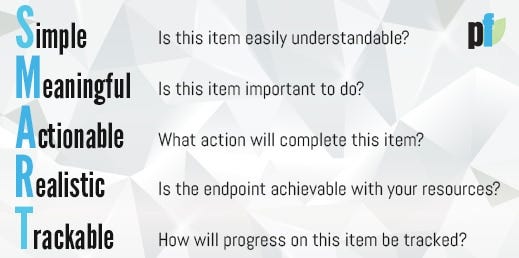A SMART Goal Is a Meaningful One
I may be biased but I like this construct better: it speaks more to my creative soul.
Important PSA: You don’t have to wait for a magical date on the calendar to set plans.
There is no governing body that will come after you for kicking off your plans on whatever date works best for you.
Start now. Start tomorrow. Start when you’re ready. Just don’t wait for a Monday or the first of any particular month. Okay, tangent over.
Whether you plan according to the calendar year or are on your own personal schedule, the date you start is less important than setting the direction you want to head.
So no matter when you plan, or what time perspective you’re planning against, you’ll want to make sure you set the course by creating a SMART goal for your project.
Is Your Goal Traditionally SMART… And Meaningful?
The idea of SMART goals is not a new one. You may be familiar with the original formation of SMART: specific, measurable, attainable, realistic, and timely.
But of course, we do things differently here at PF so we’ve made some modifications. Here’s our version of the SMART goal formulation:
Simple: It’s clear — you can look at it and know at a glance what needs to be done.
Meaningful: You understand its importance — it connects with both your mind and your heart.
Actionable: You know what action needs to be taken to accomplish it (i.e. your goal starts with an action verb).
Realistic: You have the time and resources you need to succeed.
Trackable: It’s clear what progress means because you have some metric to track it against.
I may be biased but I like this construct better: it speaks more to my creative soul. This structure has more heart and more energy so I feel more motivated to move a project forward using it.
What the Shift from Measurable to Meaningful Does
I’ve been trying to establish a daily writing practice for a while now but for a long time couldn’t seem to stick with it. I’d be good with it for the first few days, then skip a day, then another, then a whole week will have gone by, and I’d start to figure: ‘What’s the point?’
The intent of the goal wasn’t flawed but my formulation needed some tweaking.
My Monthly Goal: Establish a daily writing practice. This hits all the aspects of the traditional SMART goal formulation:
It’s Specific: Write daily.
It’s Measurable: I can measure the number of days, time spent, words written, etc.
It’s Attainable: I can certainly find a small amount of time each day to write.
It’s Realistic: I have the resources (time, instruments to write with, I can string words together).
It’s Timely: By the end of the month, I should have 30 days of writing.
But as I mentioned, try as I might, I was unable to achieve my goal.
So what was missing? Let’s look at the same goal through the lens of a SMART goal by PF’s standard☝️:
Is it Simple?
At first glance, yes. But I may want to revisit the word “establish” since it’s unclear what that requires.
Is it Meaningful?
No. I’m not clear on why I’m doing this — how it serves me or others.
Is it Actionable?
Yes, I need to write. But without knowing why I’m doing this it remains unclear if this is the appropriate action verb I need here.
Is it Realistic?
Yes (see above).
Is it Trackable?
Yes. I can track the number of days, the number of words, time spent, etc. And since part of this is to get into a habit, these metrics make sense — but once the habit is established these metrics may no longer track real progress.
Clearly, for me, the key is giving my goal meaning as that informs all the other factors.
You might gravitate towards the action verb you choose. Or maybe it’s the idea of tracking something outside of time that appeals to you. We need all five factors for it to be truly SMART — but if you figure out your anchor point you can use that to help bring your goal to fulfill the other four qualities.
UPDATE: I was eventually able to create a goal the met the SMART criteria and in the process discovered what my goal really was.
Check out the Start Finishing Field Guide, which includes exercises to help you convert your idea into a project — including crafting SMART goals.




